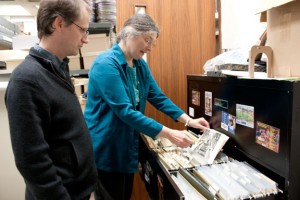In honor of the Ithaca College Campus Center’s 50th anniversary, the college library’s staff plans to extensively update historical archives through multimedia and development of an Oral History Project.
Originally started in 2006, the Oral History Project is a collection of interviews that now includes 45 audio recordings of former faculty and administrators recounting the college’s history. Recent interviewees include President Emerita Peggy Ryan Williams and former School of Music Dean Art Ostrander.

Lisabeth Chabot, a staff librarian involved with the project, said the college’s records are long overdue for an overhaul. The most current college history dates from 1983 in the form of “The Ithaca College Story,” written by former college English professor John B. Harcourt.
The book chronicles the development of the college from its beginnings in 1892 as a small music conservatory based in Ithaca up to the year 1975, but does not contain information on any years afterward.
The project’s multimedia branch, IC Stories, takes a different approach to adding depth to existing records. Librarians and historians invite alumni, former faculty and friends of the college to respond via audio or e-mail memoirs to certain historic photographs posted on the library’s website.
Chabot said that while IC Stories is heavily based in usage of new storage media for historical documents, the project involves much more than simply updating existing information to a digital format.
“We have a large collection of images, but no stories to give a fuller history of the college,” she said. “For example, we have several images of Rod Serling working with students but no stories to accompany and enrich the collection.”
The IC Stories staff will post new images to the website on a monthly basis to allow different people to share their memories of the college. A photograph of the campus bowling alley, once located in the basement of the Hill Center, was among the first to be uploaded.
The multi-point project also includes the digitization of an extensive collection of images from the college’s early days. From the 1950s into the 1980s, photographer C. Hadley Smith provided historical coverage of the college’s transition from the original campus, located in downtown Ithaca, to its current South Hill location, as well as the new campus’ growth since its original construction in the 1960s.
Smith’s original prints and negatives are stored in the archives, but college historians are currently working to upload the images to a regional collection website.
Sophomore Caitlin Davis said she is looking forward to the records being updated.
“It’s a very different way of recording history,” she said. “We’re all so used to just reading it out of a book. Recording it all orally means you can actually hear people’s voices and get their feelings and emotions about what they remember.”
Smith’s images have been interwoven with footage of current facilities to create the first in a series of videos commemorating the Campus Center’s anniversary and highlighting the changes that have taken place since the college’s foundation.
Andrew Darby, a research librarian affiliated with the project, said the endeavor holds many possibilities.
“We’re trying to capture the unique history of every building on campus,” he said. “Every one of these places has a story to tell.”
More videos detailing the campus’ development are also in production from the college library.
Chabot said that while taking advantage of new technologies is a primary focus of the projects, written historical records are still of great value.
“At some time in the future, the college may decide to develop an updated written history, but in the meantime, the library is using digital media to enrich its collections,” she said.
The Oral History Project recordings are available on the library’s website, along with the IC Stories Project’s collection of historic images and the commemorative video series. The Smith collection can also be viewed online through the site “Tools of History.”







